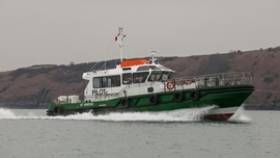Displaying items by tag: New Pilot Cutters
New 'Saint' Pilot Boats to Keep Largest UK Energy Port Operating
#NewPilotCutters -The first of three 19m pilot boats built by Mainstay Marine Solutions, St. Brides, has been delivered to the Port of Milford Haven in south-west Wales.
The new craft was officially blessed last Thursday by Father Harri Williams of St Katherine’s and St Peter’s Church, before coming into full service.
The 48 tonne vessel is of a similar design to the ‘Picton’ pilot boat delivered to the Port in 2009. Designed by Camarc Design, these vessels have proven reliability of service over many years in the challenging sea conditions which can be found in and around the Port of Milford Haven.
Capable of reaching up to 14 knots with 12 persons on board, the crafts are designed to be used extensively in heavy weather and are likely to operate in swells up to 5m in wave height. They are able to withstand the impact of coming alongside large tankers in turbulent sea conditions and provide a safe platform when transferring pilots to and from ships visiting the various terminals along the Milford Haven Waterway. The boats are fully equipped with the latest safety and operational features and meet the highest standards of reliability and crew safety.
Alec Don, Chief Executive of the Port of Milford Haven, said: “This substantial investment of over £3.6 million in the complete renewal of our pilot boat fleet will provide the port with three identical, modern, state-of-the-art boats with full interchangeability of parts. These boats, together with our highly skilled and trained crews, constitute the backbone of our ability to provide a safe and reliable service to our customers 24 hours a day, 7 days a week. We have been impressed with the professional design and fabrication service delivered by Mainstay Marine Solutions who have delivered exactly in line with the contract”.
Stewart Graves, Managing Director of Mainstay Marine Solutions, commented: “We pride ourselves on our reputation for quality so the positive feedback on the finish of the St Brides pilot boat has been particularly pleasing. Delivering three vessels in quick succession has been a welcome challenge and we are on track to deliver the remaining two vessels to the Port of Milford Haven on time, and to budget.”
The three new vessels will replace the Port’s current fleet of four, the ‘Skomer’ and ‘Picton’ which were delivered in 2007 and 2009 respectively in readiness for the arrival of LNG, the ‘Portunus’, and the Port’s oldest vessel, the ‘Hakin’, which has been operating on the Haven since the early 1980s.
‘St Brides’ was named following a public competition which attracted almost one hundred entries. A traditional marine naming ceremony will take place for all three vessels later this year.





























































